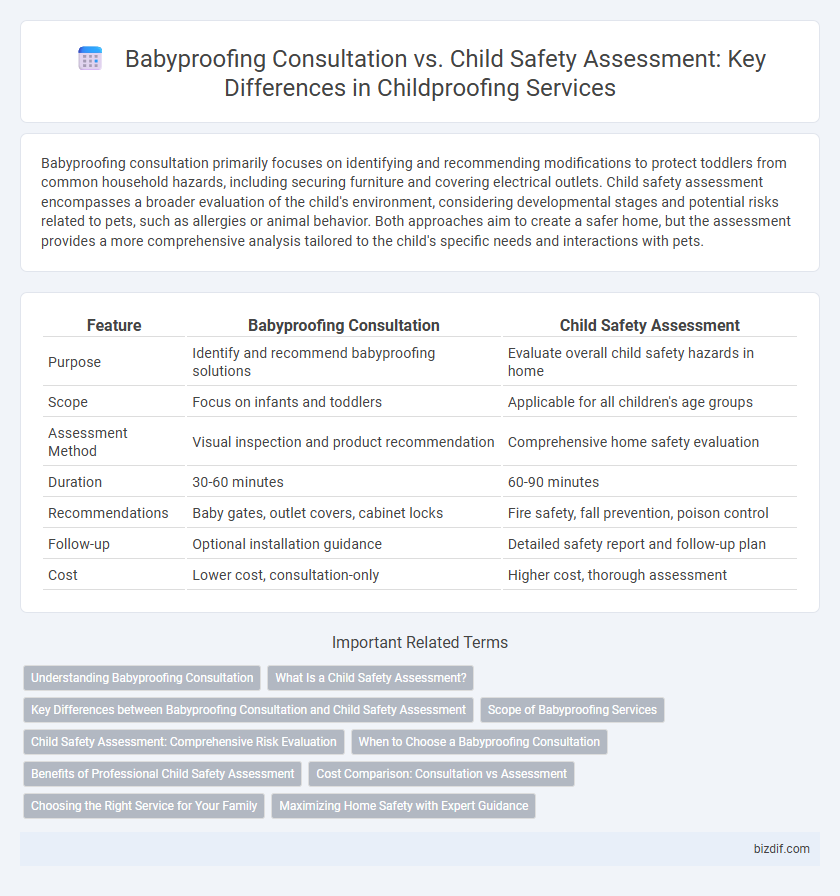Babyproofing consultation primarily focuses on identifying and recommending modifications to protect toddlers from common household hazards, including securing furniture and covering electrical outlets. Child safety assessment encompasses a broader evaluation of the child's environment, considering developmental stages and potential risks related to pets, such as allergies or animal behavior. Both approaches aim to create a safer home, but the assessment provides a more comprehensive analysis tailored to the child's specific needs and interactions with pets.
Table of Comparison
| Feature | Babyproofing Consultation | Child Safety Assessment |
|---|---|---|
| Purpose | Identify and recommend babyproofing solutions | Evaluate overall child safety hazards in home |
| Scope | Focus on infants and toddlers | Applicable for all children's age groups |
| Assessment Method | Visual inspection and product recommendation | Comprehensive home safety evaluation |
| Duration | 30-60 minutes | 60-90 minutes |
| Recommendations | Baby gates, outlet covers, cabinet locks | Fire safety, fall prevention, poison control |
| Follow-up | Optional installation guidance | Detailed safety report and follow-up plan |
| Cost | Lower cost, consultation-only | Higher cost, thorough assessment |
Understanding Babyproofing Consultation
Babyproofing consultation involves a detailed evaluation of an infant's immediate environment to identify and mitigate hazards specific to babies' developmental stages. Experts provide tailored recommendations on securing furniture, electrical outlets, and choking hazards, ensuring a safe space for crawling and early walking. This service focuses primarily on preventing accidents common to infants, differentiating it from broader child safety assessments that address risks for toddlers and older children.
What Is a Child Safety Assessment?
A Child Safety Assessment is a comprehensive evaluation designed to identify potential hazards in the home environment that could pose risks to children of various ages. Unlike a Babyproofing consultation that primarily targets infants, this assessment considers the developmental stages and specific safety needs of toddlers and older children. It covers areas such as electrical outlets, furniture stability, toxic substances, and emergency preparedness to create a tailored safety plan ensuring broad protectiveness.
Key Differences between Babyproofing Consultation and Child Safety Assessment
Babyproofing consultation centers on identifying and recommending specific safety products and modifications to secure a home environment for infants, focusing primarily on preventing accidents related to crawling and early mobility stages. Child safety assessment involves a comprehensive evaluation of hazards across various home areas tailored to the child's age, development, and behavior, addressing potential risks beyond just babyproofing needs. Unlike babyproofing consultations, child safety assessments provide detailed reports and actionable plans that encompass broader safety concerns such as fire hazards, choking risks, and emergency preparedness.
Scope of Babyproofing Services
Babyproofing consultation primarily focuses on evaluating the home environment to identify and mitigate risks specific to infants, including securing furniture, covering electrical outlets, and installing safety gates. Child safety assessment encompasses a broader evaluation that addresses hazards for toddlers and young children, such as examining window guards, assessing toy safety, and ensuring proper storage of household chemicals. Both services aim to create a safer living space, but babyproofing consultation is specialized for newborns and crawling infants, while child safety assessments cover a wider age range with more comprehensive risk factors.
Child Safety Assessment: Comprehensive Risk Evaluation
Child safety assessment involves a comprehensive risk evaluation that identifies potential hazards in the home environment, focusing on all areas where children may be at risk of injury. This assessment goes beyond basic babyproofing consultation by examining electrical outlets, furniture stability, toxic substances, and emergency preparedness to create a detailed safety plan. Professional child safety assessments provide personalized recommendations to mitigate risks and enhance overall child protection effectively.
When to Choose a Babyproofing Consultation
Choose a babyproofing consultation when expecting a newborn or setting up a nursery to ensure all potential hazards are identified and addressed proactively. This service provides customized recommendations on securing furniture, outlet covers, and creating safe play areas tailored to your child's developmental stage. Opt for this consultation early to implement prevention measures before your baby becomes mobile and curious.
Benefits of Professional Child Safety Assessment
Professional child safety assessments provide a comprehensive evaluation of the home environment, identifying hidden hazards that generic babyproofing consultations might overlook. Certified experts use detailed checklists and industry standards to tailor safety solutions specific to the child's developmental stage and household layout. This targeted approach significantly reduces the risk of accidents, ensuring a safer living space for children.
Cost Comparison: Consultation vs Assessment
Babyproofing consultations typically cost between $100 and $300, focusing on identifying potential hazards and recommending safety products tailored to the home's layout. Child safety assessments usually range from $150 to $400, offering a more comprehensive analysis that includes behavioral evaluations and customized safety strategies. Choosing between a consultation or assessment depends on budget and the desired depth of safety evaluation for the child's environment.
Choosing the Right Service for Your Family
Choosing the right service for your family depends on whether you need a babyproofing consultation or a child safety assessment, each catering to different developmental stages and safety concerns. Babyproofing consultations focus on infant-specific hazards, providing tailored solutions like outlet covers and cabinet locks to prevent accidents. Child safety assessments offer comprehensive evaluations for older children, addressing broader risks such as fall hazards, choking dangers, and emergency preparedness to ensure a safe environment as they grow.
Maximizing Home Safety with Expert Guidance
Babyproofing consultation offers tailored strategies to secure dangerous areas and recommend age-appropriate safety products, directly addressing specific infant risks. Child safety assessment evaluates overall household hazards for toddlers and young children, identifying potential dangers like sharp edges, toxic substances, and unsafe furniture. Expert guidance in both services maximizes home safety by creating comprehensive, customized action plans that adapt as a child grows.
Babyproofing consultation vs Child safety assessment Infographic

 bizdif.com
bizdif.com